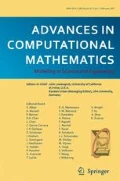Abstract
Recent investigations of discretization schemes for the efficient numerical solution of boundary value ordinary differential equations (BVODEs) have focused on a subclass of the well‐known implicit Runge–Kutta (RK) schemes, called mono‐implicit RK (MIRK) schemes, which have been employed in two software packages for the numerical solution of BVODEs, called TWPBVP and MIRKDC. The latter package also employs continuous MIRK (CMIRK) schemes to provide C 1 continuous approximate solutions. The particular schemes implemented in these codes come, in general, from multi‐parameter families and, in some cases, do not represent optimal choices from these families. In this paper, several optimization criteria are identified and applied in the derivation of optimal MIRK and CMIRK schemes for orders 1–6. In some cases the schemes obtained result from the analysis of existent multi‐parameter families; in other cases new families are derived from which specific optimal schemes are then obtained. New MIRK and CMIRK schemes are presented which are superior to those currently available. Numerical examples are provided to demonstrate the practical improvements that can be obtained by employing the optimal schemes.
Similar content being viewed by others
References
U.M. Ascher, R.M.M. Mattheij and R.D. Russell, Numerical Solution of Boundary Value Problems for Ordinary Differential Equations, Classics in Applied Mathematics Series (SIAM, Philadelphia, PA, 1995).
W.M.G. van Bokhoven, Efficient higher order implicit one-step methods for integration of stiff differential equations, BIT 20 (1980) 34-43.
D.L. Brown and J. Lorenz, A high-order method for stiff boundary value problems with turning points, SIAM J. Sci. Statist. Comput. 8 (1987) 790-808.
K. Burrage, F.H. Chipman and P.H. Muir, Order results for mono-implicit Runge-Kutta methods, SIAM J. Numer. Anal. 31 (1994) 876-891.
J.C. Butcher, The Numerical Analysis of Ordinary Differential Equations (Wiley, Chichester, 1987).
J.R. Cash, A class of implicit Runge-Kutta methods for the numerical integration of stiff differential systems, J. ACM 22 (1975) 504-511.
J.R. Cash, On the numerical integration of nonlinear two-point boundary value problems using iterated deferred corrections, Part 1: A survey and comparison of some one-step formulae, Comput. Math. Appl. 12a (1986) 1029-1048.
J.R. Cash and D.R. Moore, A high order method for the numerical solution of two-point boundary value problems, BIT 20 (1980) 44-52.
J.R. Cash and A. Singhal, High order methods for the numerical solution of two-point boundary value problems, BIT 22 (1982) 184-199.
J.R. Cash and A. Singhal, Mono-implicit Runge-Kutta formulae for the numerical integration of stiff differential systems, IMA J. Numer. Anal. 2 (1982) 211-227.
J.R. Cash and M.H. Wright, A deferred correction method for nonlinear two-point boundary value problems: implementation and numerical evaluation, SIAM J. Sci. Statist. Comput. 12 (1991) 971-989.
W.H. Enright, The relative efficiency of alternative defect control schemes for high-order continuous Runge-Kutta formulas, SIAM J. Numer. Anal. 30 (1993) 1419-1445.
W.H. Enright and P.H. Muir, Efficient classes of Runge-Kutta methods for two-point boundary value problems, Computing 37 (1986) 315-334.
W.H. Enright and P.H. Muir, A Runge-Kutta type boundary value ODE solver with defect control, Technical Report 267/93, Department of Computer Science, University of Toronto (1993).
W.H. Enright and P.H. Muir, Runge-Kutta software with defect control for boundary value ODEs, SIAM J. Sci. Comput. 17 (1996) 479-497.
W.H. Enright and P.H. Muir, Superconvergent continuous Runge-Kutta schemes for discrete collocation solutions, submitted to SIAM J. Sci. Comput. (1997).
S. Gupta, An adaptive boundary value Runge-Kutta solver for first order boundary value problems, SIAM J. Numer. Anal. 22 (1985) 114-126.
R. Frank, J. Schneid and C.W. Ueberhuber, Order results for implicit Runge-Kutta methods applied to stiff systems, SIAM J. Numer. Anal. 22 (1985) 515-534.
H.-O. Kreiss, N.K. Nichols and D.L. Brown, Numerical methods for stiff two-point boundary value problems, SIAM J. Numer. Anal. 23 (1986) 325-368.
P.H. Muir, A note on continuous Runge-Kutta schemes with sub-optimal stage orders, Congr. Numer. 106 (1995) 105-118.
P.H. Muir and W.H. Enright, Relationships among some classes of implicit Runge-Kutta methods and their stability functions, BIT 27 (1987) 403-423.
P.H. Muir and B. Owren, Order barriers and characterizations for continuous mono-implicit Runge-Kutta schemes, Math. Comp. 61 (1993) 675-699.
P.W. Sharp, Fortran software for computation of error coefficients of Runge-Kutta and Runge-Kutta-Nyström methods, private communication, University of Auckland, Auckland, New Zealand (1995).
P.W. Sharp and E. Smart, Explicit Runge-Kutta pairs with one more derivative evaluation than the minimum, SIAM J. Sci. Comput. 14 (1993) 338-348.
R. Scherer and H. Türke, Reflected and transposed methods, BIT 23 (1983) 262-266.
H. Stetter, The Analysis of Discretization Methods for Ordinary Differential Equations (Springer, Berlin, 1982).
J. Stoer and R. Bulirsch, Introduction to Numerical Analysis (Springer, New York, 1980).
J.H. Verner, Differentiable interpolants for high-order Runge-Kutta methods, SIAM J. Numer. Anal. 30 (1993) 1446-1466.
J.H. Verner and P.W. Sharp, Completely imbedded Runge-Kutta formula pairs, SIAM J. Numer. Anal. 31 (1994) 1169-1190.
Waterloo Maple Software, Waterloo, Ontario, Canada.
R. Weiss, The application of implicit Runge-Kutta and collocation methods to boundary value problems, Math. Comp. 28 (1974) 449-464.
Author information
Authors and Affiliations
Rights and permissions
About this article
Cite this article
Muir, P. Optimal discrete and continuous mono‐implicit Runge–Kutta schemes for BVODEs. Advances in Computational Mathematics 10, 135–167 (1999). https://doi.org/10.1023/A:1018926631734
Issue Date:
DOI: https://doi.org/10.1023/A:1018926631734




